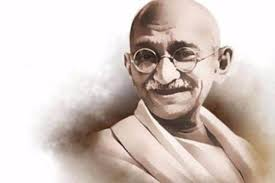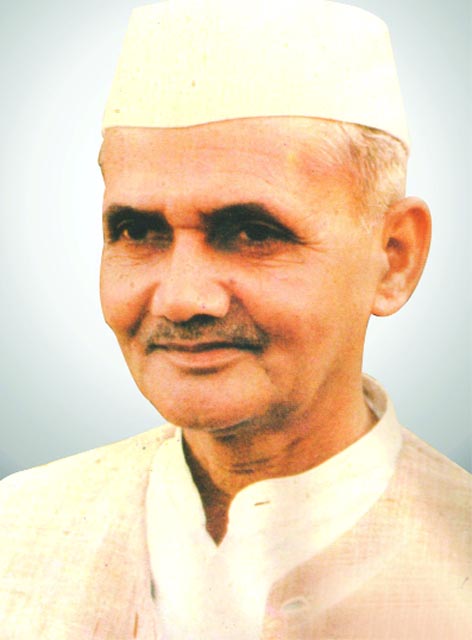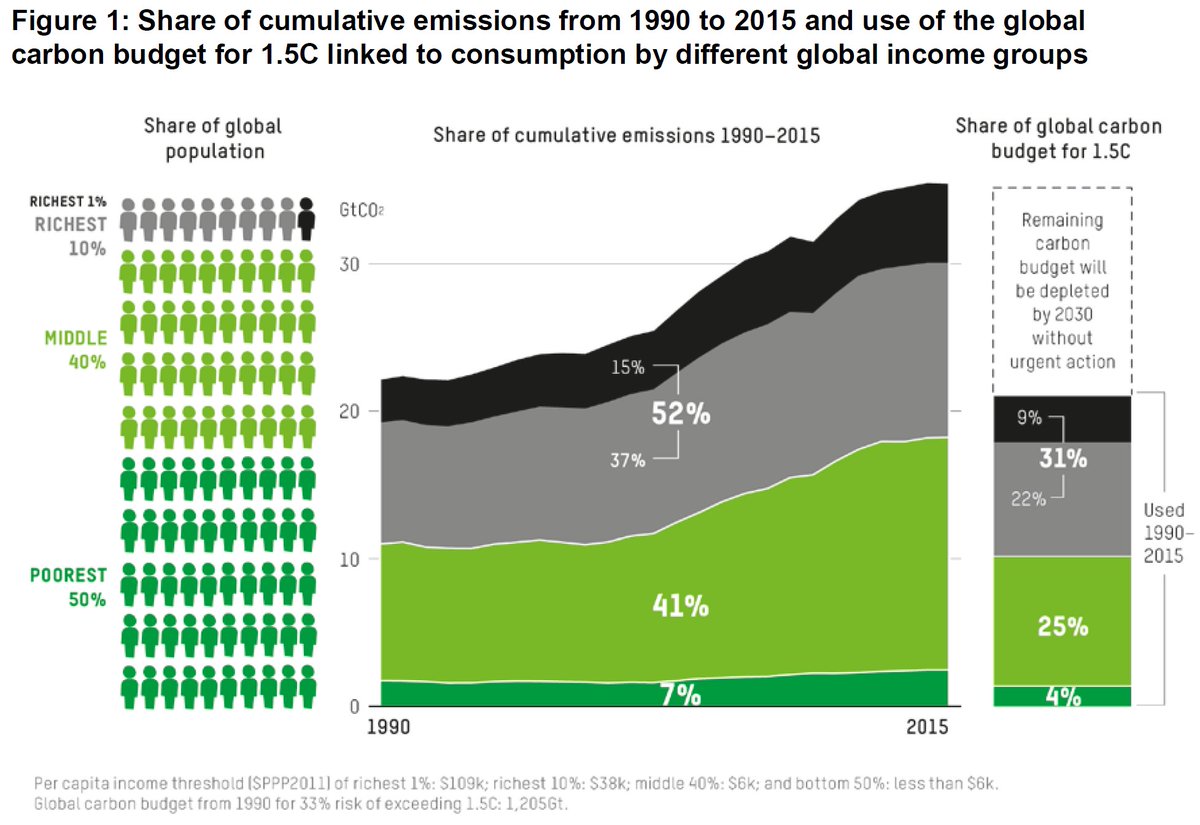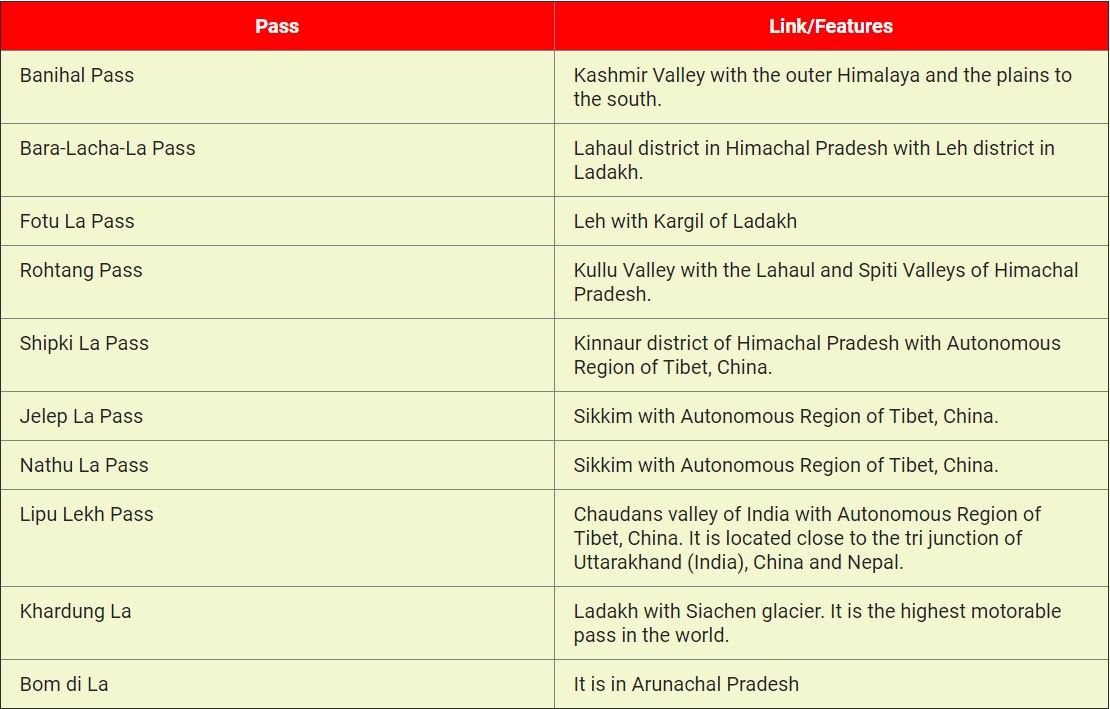More Contribution to Emissions by Rich
Why in News
Recently, the Oxfam International and the Stockholm Environmental Institute (SEI) has released a report titled “Confronting Carbon Inequality”, which highlights that a rich person contributes more to the climate crisis than a poor person.
- Oxfam is a global organisation with affiliates in 20 countries, working together to end the injustice of poverty.
- SEI is an international non-profit research and policy organisation which promotes sustainability in policy making.
Key Points
- Data Analysis from 1990 to 2015:
- Cumulative Emissions: The richest 1% of humanity accounted for 15% of cumulative emissions, while the poorest 50% accounted for only 7%.
- Depletion of Global Carbon Budget: The richest 10% depleted the global carbon budget by 31% and the poorest 50% used only 4% of the carbon budget.
- A carbon budget is a cumulative amount of carbon dioxide (CO2) emissions permitted over a period of time to keep within a certain temperature threshold.
- Emissions Growth: While the richest 10% accounted for 46% of emissions growth, the poorest 50% accounted for only 6%.
- About half of the emissions of the richest 10% are associated with North America and the European Union (EU).
- Indian Comparison with Others:
- An Indian emitted only 1.97 tonnes of CO2 (tCO2) annually, while Americans and Canadians both emitted well over 16 tCO2.
- The per capita CO2 emissions of the richest 10% of Indians were about 4.4 tonnes in 2018, in comparison to the per capita emissions of the richest 10% Americans were 52.4 tonnes, almost 12 times that of the richest Indians.
- India’s per capita emissions were a fraction of not just the EU (6.78 tCO2/person), but also China (7.95 tCO2/person), making it the lowest per capita emitter amongst the world’s large economies.
- Highlighted Concerns:
- The global carbon budget is being rapidly depleted due to the increasing consumption of the rich in the name of dignity and a decent standard of living.
- Of this increased consumption, the largest share of emissions by the rich was from flights and cars, including private jets, luxury SUVs and sports cars.
- Also, the report briefly acknowledged the intersectionality of income inequality and the climate crisis with factors such as race, class, gender, caste and age.
- For example, gender pay inequity meant that men earned higher wages than women which led to higher spendings and more travels.
- Global consumption and production models are driven by tenets of capitalistic growth and neoliberalism and it is impossible to decouple those systems from resource extraction and environmental degradation.
- Moderate measures such as carbon tax and non-binding climate commitments from corporations and countries are inadequate while considering the scale of transformation.
- The global carbon budget is being rapidly depleted due to the increasing consumption of the rich in the name of dignity and a decent standard of living.
- Suggestions:
- Systemic change rather than a sole focus on individual action.
- Clip emissions of the richest 10% and reduce the per capita footprint to the 1.5°C-consistent level by 2030 which would cut annual carbon emissions by over a third.
- Call for “new economic models that do not depend on the endless growth in consumption of the already affluent”.
- This is a departure from the mainstream discourse on climate solutions which tends to focus on changes in behaviour and personal habits such as driving electric vehicles and consuming less meat.
- Comprehensive approaches like the Green New Deal (popular in the USA in 2018 and different from the European Green Deal), which might help avert the worst of the climate crisis amid widespread income inequality and imbalanced power structures.
- The Green New Deal combines a series of goals including 100% renewable energy, along with full access to health care and guaranteed wages.
- The United Nations Conference on Trade and Development (UNCTAD) echoed the same in 2019 and called for a global iteration of a Green New Deal through a large-scale investment push led by the public sector instead of the private sector.
- Wealth redistribution via taxes on the wealthiest, rapid decarbonisation via large-scale public investments in clean energy and low carbon transportation, mass mobilization and the creation of a social safety net through measures like jobs guarantee programme and universal healthcare.
Way Forward
- The findings of study highlights the importance of the concept of Common But Differentiated Responsibilities (CBDR) which establishes that all states are responsible for addressing global environmental destruction yet not equally responsible.
- The general principles of equity in international law must be adhered to. The historical correlation between higher levels of development and a greater contribution to the degradation of global environmental resources, such as water and air, must be recognised.
- Therefore, the developed countries, which had been able to develop for longer times unimpeded by environmental restrictions, now need to take a greater share of responsibility.
Mahatma Gandhi Jayanti
Why in News
2nd October 2020 was the 151st birth anniversary of the Father of the Nation - Mahatma Gandhi. The Swachh Bharat Diwas, 2020 was celebrated on the occasion of Gandhi Jayanti with the distribution of Swachh Puraskar by the Ministry of Jal Shakti.
- Gandhi was a social reformist and leader of Indian Independence Movement who introduced the idea of nonviolent resistance called Satyagrah.
Key Points
- Birth: 2nd October 1869 in Porbandar (Gujarat)
- Brief Profile: Lawyer, politician, social activist, and writer who became the leader of the nationalist movement against the British rule of India.
- Satyagrah: In South Africa (1893-1915), he had successfully fought the racist regime with a novel method of mass agitation, which he called satyagraha.
- The idea of satyagraha emphasised the power of truth and the need to search for truth.
- It suggested that if the cause was true, if the struggle was against injustice, then physical force was not necessary to fight the oppressor. Without seeking vengeance or being aggressive, a satyagrahi could win the battle through nonviolence. This could be done by appealing to the conscience of the oppressor.
- People – including the oppressors – had to be persuaded to see the truth, instead of being forced to accept truth through the use of violence. By this struggle, truth was bound to ultimately triumph.
- The International Day of Non-Violence is observed on 2nd October, the birthday of Mahatma Gandhi.
- Gandhi Peace Prize is given for social, economic and political transformation through non-violence and other Gandhian methods.
- Return to India: He returned to India from South Africa on 9th January 1915.
- Pravasi Bharatiya Divas (PBD) is celebrated on 9th January every year to mark the contribution of Overseas Indian community in the development of India.
- Satyagraha Movements in India: Mahatma Gandhi believed that the dharma of non-violence could unite all Indians.
- In 1916 he travelled to Champaran in Bihar to inspire the peasants to struggle against the oppressive plantation system.
- In 1917, he organised a satyagraha to support the peasants of the Kheda district of Gujarat. Affected by crop failure and a plague epidemic, the peasants of Kheda could not pay the revenue, and were demanding that revenue collection be relaxed.
- In 1918, he went to Ahmedabad to organise a satyagraha movement amongst cotton mill workers.
- In 1919, he decided to launch a nationwide satyagraha against the proposed Rowlatt Act (1919).
- The Act gave the government enormous powers to repress political activities, and allowed detention of political prisoners without trial for two years.
- On 13th April, 1919 the infamous Jallianwalla Bagh incident took place. Seeing violence spread, Mahatma Gandhi called off the movement (18th April, 1919).
- Non-Cooperation Movement (1920-22): At the Calcutta session of the Congress in September 1920, he convinced other leaders of the need to start a non-cooperation movement in support of Khilafat as well as for swaraj.
- At the Congress session at Nagpur in December 1920, the Non-Cooperation programme was adopted.
- In February 1922, Mahatma Gandhi decided to withdraw the Non-Cooperation Movement after the Chauri-Chaura incident.
- The Salt March and the Civil Disobedience Movement: For several years after the Non-cooperation Movement ended, Mahatma Gandhi focused on his social reform work.
- In 1930, Gandhiji declared that he would lead a march to break the salt law.
- According to this law, the state had a monopoly on the manufacture and sale of salt.
- The march was over 240 miles, from Gandhi's ashram in Sabarmati to the Gujarati coastal town of Dandi, where they broke the government law by gathering natural salt found on the seashore, and boiling sea water to produce salt.
- This marked the beginning of the Civil Disobedience Movement.
- In 1931, Gandhi accepted a truce (the Gandhi-Irwin Pact), called off civil disobedience, and agreed to attend the Second Round Table Conference in London as the sole representative of the Indian National Congress.
- After returning from London, Mahatma Gandhi relaunched the Civil Disobedience Movement. For over a year, the movement continued, but by 1934 it lost its momentum.
- In 1930, Gandhiji declared that he would lead a march to break the salt law.
- Quit India Movement:
- With the outbreak of World War II (1939-45), the nationalist struggle in India entered its last crucial phase.
- The failure of the mission of Sir Stafford Cripps, a British cabinet minister who went to India in March 1942 with an offer that Gandhi found unacceptable, the British equivocation on the transfer of power to Indian hands, and the encouragement given by high British officials to conservative and communal forces promoting discord between Muslims and Hindus impelled Gandhi to demand in the summer of 1942 an immediate British withdrawal from India—what became known as the Quit India Movement.
- Social Work:
- He worked for the upliftment of untouchables and gave them a new name 'Harijan' meaning the children of God.
- In September 1932, B.R. Ambedkar negotiated the Poona Pact with Mahatma Gandhi.
- His symbol of self-reliance - the spinning wheel - became a popular symbol of Indian Independence Movement.
- He played a key role in pacifying people and averting the Hindu-Muslim riots as tensions rose before and during the partition of the country.
- He founded the Hindustani Prachar Sabha in 1942 at Wardha in Maharashtra. The aim of the organisation was to promote Hindustani, a link language between Hindi and Urdu.
- He worked for the upliftment of untouchables and gave them a new name 'Harijan' meaning the children of God.
- Books Written: Hind Swaraj, My Experiments with Truth (Autobiography)
- Death: He was shot dead by Nathuram Godse on 30th January, 1948.
- 30th January is observed as Martyrs' Day.
Good Conduct and Early Release: SC
Why in News
Recently, the Supreme Court has held that the length of a prison sentence or the gravity of the crime cannot be the sole basis for denying a convict premature release from jail.
Key Points
- Background:
- The judgment came in a plea made by two prisoners who have been imprisoned for a botched kidnapping for ransom case in Uttar Pradesh.
- They are in their early middle age with a record of good conduct in jail.
- The court held that “their action of kidnapping was nothing but a fanciful attempt to procure easy money, for which they have learnt a painful life lesson” and ordered their release.
- Judgement:
- The three-judge bench held that an assessment of the tendency to commit a crime upon release “must be based on antecedents as well as the conduct of the prisoner while in jail, and not merely on his age or apprehensions of the victims and witnesses”.
- Reformative justice should not merely focus on public harmony but should foster brotherhood and mutual acceptability.
- First-time offenders should especially be given a second chance at life allowing them to look forward to a bright future.
Criminal Justice System in India
- The Criminal Justice System refers to the agencies of government charged with enforcing the law, adjudicating crime, and correcting criminal conduct.
- The criminal justice system is essentially an instrument of social control:
- Society considers some behaviours so dangerous and destructive that it either strictly controls their occurrence or outlaws them outright.
- It is the job of the agencies of justice to prevent these behaviours by apprehending and punishing transgressors or deterring their future occurrence.
- Retributive Justice:
- It is a system of criminal justice based on the punishment of offenders rather than on rehabilitation.
- It holds that when an offender breaks the law, justice requires that they must suffer in return. It also requires that the response to a crime must be proportional to the committed offence.
- Reformative or Restorative Justice:
- It is generally the most appreciated theory of punishment as it believes in the concept that the object is to extinct crime and not the criminal.
- It believes that nobody is born as a criminal and it is only the consequences of those circumstances which were around the offender/criminal.
- Objective of Criminal Justice System:
- To prevent the occurrence of crime.
- To punish the transgressors and the criminals.
- To rehabilitate the transgressors and the criminals.
- To compensate the victims as far as possible.
- To maintain law and order in society.
- To deter offenders from committing any criminal act in the future.
- Challenges:
- Ineffectiveness: The system had to protect the rights of the innocents and punish the guilty, but nowadays it has become a tool of harassment for common people.
- Pendency of Cases: According to Economic Survey 2018-19, there are about 3.5 crore cases pending in the judicial system, especially in the district and subordinate courts, which leads to the actualisation of the maxim “Justice delayed is justice denied”.
- Huge Undertrials: India has one of the world’s largest number of undertrial prisoners.
- Inefficiency of Police: Police being the front liner in the criminal judiciary system, plays a vital role in the administration of justice. However, corruption, huge workload and accountability of police is a major hurdle in speedy and transparent delivery of justice.
- Solutions:
- The reason for victimisation should be given a major thrust in reforming laws to identify the rights of crime victims.
- The construction of new offences and reworking of the existing classification of offences must be guided by the principles of criminal jurisprudence which have substantially altered in the past four decades.
- The classification of offences must be done in a manner conducive to the management of crimes in the future.
- Guiding principles need to be developed after sufficient debate before criminalising an act as a crime.
- The discretion of judges in deciding the quantum and nature of sentence differently for crimes of the same nature should be based on principles of judicial precedent.
Way Forward
- Society has a right to lead a peaceful and fearless life, without free-roaming criminals creating havoc in the lives of ordinary peace-loving citizens.
- However, equally strong is the foundation of reformative theory, which propounds that a civilised society cannot be achieved only through punitive attitudes and vindictiveness.
Data Governance Quality Index: NITI Aayog
Why in News
The Department of Fertilizers (Ministry of Chemicals and Fertilizers) has been ranked 3rd out of the 65 Ministries/Departments with a score 4.11 on a scale of 5 on Data Governance Quality Index (DGQI).
- It has been ranked 2nd amongst the 16 Economic Ministries/Departments.
Key Points
- Data Governance Quality Index (DGQI) survey was conducted by Development Monitoring and Evaluation Office (DMEO), Niti Aayog to assess different Ministries/Departments' performance on the implementation of Central Sector Schemes (CS) and Centrally Sponsored Schemes (CSS).
- Objective: To drive healthy competition among them and promote cooperative peer learning from best practices.
- Benefits: Improve the implementation framework of government policies, schemes and programmes to achieve the desired goals.
- Six major themes of DGQI: Data Generation; Data Quality; Use of Technology; Data Analysis, Use and Dissemination; Data Security and HR Capacity and Case Studies.
- Ministries/Departments were classified in six categories: Administrative, Strategic, Infrastructure, Social, Economic and Scientific.
Central Schemes
- The central schemes are divided into Central Sector Schemes and Centrally Sponsored Schemes (CSS).
- Central sector schemes:
- These schemes are 100% funded by the Central government.
- Implemented by the Central Government machinery.
- Formulated on subjects mainly from the Union List.
- E.g.: Bharatnet, Namami Gange-National Ganga Plan, etc.
- Centrally Sponsored Schemes are the schemes by the centre where there is financial participation by both the centre and states.
- Centrally Sponsored Schemes (CSS) are again divided into Core of the Core Schemes, Core Schemes and Optional schemes.
- Currently, there are 6 core of the core schemes while 22 core schemes.
- Most of these schemes prescribe specific financial participation by states. For example, in the case of MGNREGA, state governments have to incur 25% material expenditure.
- The 6 core of the core CSS are:
- National Social Assistance Programme
- Mahatma Gandhi National Rural Employment Guarantee Program
- Umbrella Scheme for Development of Scheduled Castes
- Umbrella Programme for Development of Scheduled Tribes
- Umbrella Programme for Development of Minorities
- Umbrella Programme for Development of Other Vulnerable Groups
Development Monitoring and Evaluation Office
- The Development Monitoring and Evaluation Office (DMEO) was constituted in September 2015 by merging the erstwhile Program Evaluation Office (PEO) and the Independent Evaluation Office (IEO).
- It is an attached office under NITI Aayog, aimed at fulfilling the organization’s monitoring and evaluation (M&E) mandate and building the M&E ecosystem in India.
- Its vision is to improve sustainable outcomes and impacts of the government. It aims to enable high-quality monitoring and evaluation of government programs to improve effectiveness, efficiency, equity and sustainability of service delivery, outcomes and impacts.
- Monitoring through Output-Outcome Framework: In accordance with the Union Budget for 2019-20, the Output-Outcome Framework represents an important reform towards outcome-based monitoring.This is a paradigm shift from measuring simply physical and financial progress, to a governance model based on outcomes. DMEO has been working with Ministries and Departments to develop this framework since 2017.
- Evaluation: The Government has assigned DMEO, NITI Aayog the responsibility to conduct independent third-party evaluation of all the CSS in a time-bound manner so that the findings of the evaluation are made available to appropriate authorities for determining the rationalization of the schemes.
Atal Tunnel
Why in News
The Prime Minister has inaugurated the Atal Tunnel in Himachal Pradesh’s Rohtang, which connects Solang Valley near Manali to Sissu in Lahaul and Spiti district.
Key Points
- About:
- The 9.02-km tunnel is the longest highway tunnel in the world above the height of 3,000 metres.
- It cuts through a mountain west of the Rohtang pass and will shorten the distance between Solang Valley and Sissu by around 46 km and will take around 15 minutes to cover. Earlier, it would take nearly 4 hours to travel between the two points.
- Significance:
- All year Connectivity: The Atal tunnel is the first step towards all-year connectivity to Ladakh. The tunnel has the potential to link Ladakh to Manali and Chandigarh throughout the year, as it would bypass Rohtang Pass, which is snowed in through the winter months.
- Strategic: The tunnel provides a strategic advantage to the country's armed forces by providing year-long connectivity to border areas. It will save an entire day for troops and supplies as they move towards forward posts.
- Avail Basic Facilities: The residents of Ladakh who had to face immense hardship to avail even basic facilities like healthcare and food supplies will now be able to reach Manali and connect with the rest of the country using this new tunnel. Essential commodities like petrol and vegetable supplies would also likely be available throughout the year.
- Boon for Farmers: The drop in travel time will help many, especially farmers whose precious crops like peas and potatoes will no longer rot in trucks before reaching the market.
- Boost to Tourism: Livelihoods in the tourism sector of the residents in Lahaul Valley and Ladakh would get a boost.
Rohtang Pass
- Rohtang Pass (elevation 3,978 m) is located in the state of Himachal Pradesh.
- It is present on the Pir Panjal Range of Himalayas.
Exercise Bongosagar
Why in News
The second edition of Exercise Bongosagar, bilateral naval exercise between India and Bangladesh, is scheduled to commence in Northern Bay of Bengal on 3rd October 2020.
Key Points
- Its first edition was held in 2019.
- Aim: To develop interoperability and joint operational skills through the conduct of a wide spectrum of maritime exercises and operations.
- Participants: Naval ships from both the countries along with the maritime patrol aircraft and helicopters will be participating in the exercise.
- It will be followed by the 3rd edition of India-Bangladesh Coordinated Patrol (IN-BN CORPAT), wherein both countries will undertake joint patrolling along the International Maritime Boundary Line (IMBL).
- CORPATs have strengthened understanding between both the navies and instituted measures to stop the conduct of unlawful activities.
- Significance:
- The exercise reflects the priority that Indian Navy accords to the Bangladesh Navy as part of the SAGAR (Security And Growth for All in the Region) Vision.
- This year’s edition assumes greater significance since it is being conducted during Mujib Barsho, the 100th birth anniversary of Bangabandhu Sheikh Mujibur Rahman.
- It strengthens the close and long-standing India-Bangladesh relations covering a wide spectrum of activities and interactions. Both countries share close cultural bonds and a shared vision of democratic society and a rules-based order.
Lal Bahadur Shastri Jayanti
Why in News
2nd October is the birth anniversary of Lal Bahadur Shastri. He served as the second Prime Minister of India.
Key Points
- He was born on 2nd October, 1904 in Mughalsarai, a small railway town seven miles from Varanasi in Uttar Pradesh.
- Participated in the freedom movement since 1930.
- He joined the Kashi VidyaPeeth in Varanasi, one of the many national institutions set up in defiance of the British rule.
- ‘Shastri’ was the bachelor’s degree awarded to him by the Vidya Peeth but has stuck in the minds of the people as part of his name.
- He was minister in the Union Cabinet from 1951 to 1956 when he resigned taking responsibility for the railway accident and later from 1957-1964.
- He was India’s second Prime Minister (1964-66).
- During Shastri’s brief Prime Ministership, the country faced two major challenges. While India was still recovering from the economic implications of the war with China (1962), failed monsoons, drought and serious food crisis presented a grave challenge. The country also faced a war with Pakistan in 1965.
- Shastri’s famous slogan ‘Jai Jawan Jai Kisan’, symbolised the country’s resolve to face both these challenges.
- Shastri’s Prime Ministership came to an abrupt end on 10th January 1966, when he suddenly expired in Tashkent, then in USSR and currently the capital of Uzbekistan.
- He was there to discuss and sign an agreement (Tashkent Agreement) with Muhammad Ayub Khan, the then President of Pakistan, to end the war.
- He signed an agreement with then Ceylon (now Sri Lanka) on persons of Indian origin there, in 1964 — an endorsement of the importance of neighbourhood.
- He was the first person to be posthumously awarded the Bharat Ratna (1966).


